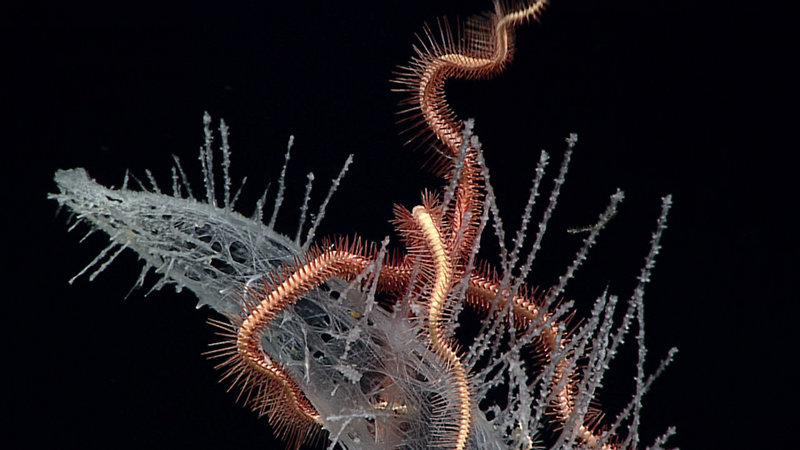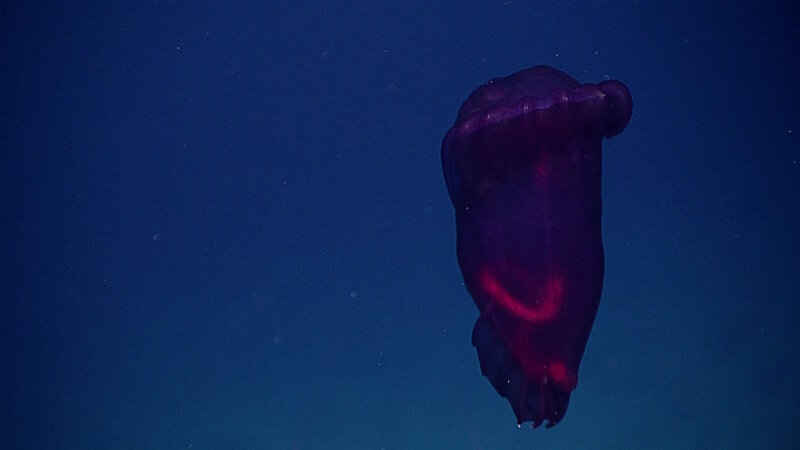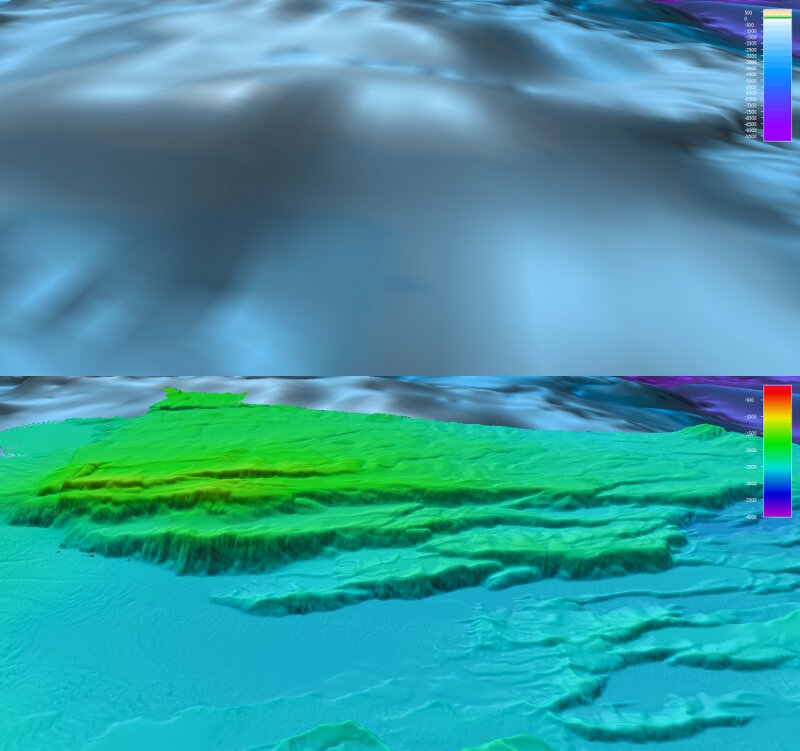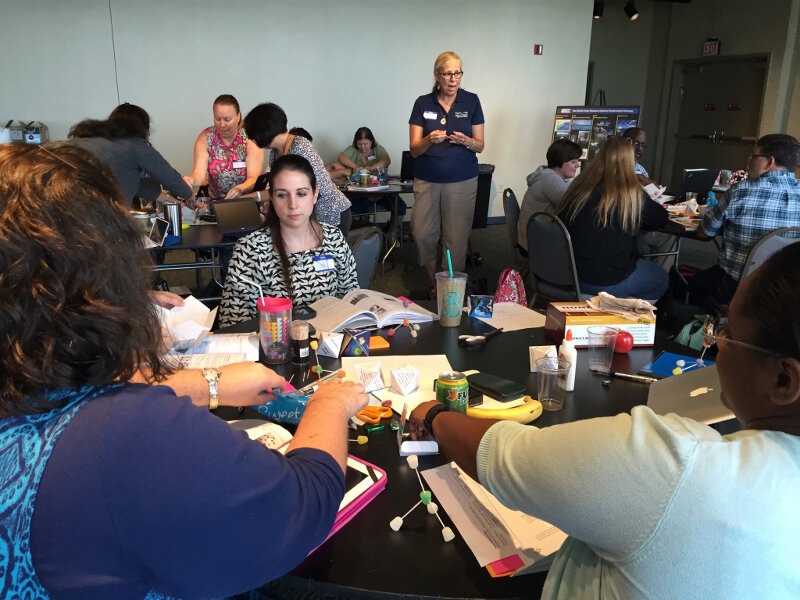
By Debi Blaney - Web Coordinator, NOAA Office of Ocean Exploration and Research
July 7, 2016

Sponge with brittle star seen on July 4th, 2016, at Fryer Guyot. Image courtesy of NOAA Office of Ocean Exploration and Research, 2016 Deepwater Exploration of the Marianas. Download larger version (jpg, 602 KB).
During the last several weeks, I served as web coordinator for the 2016 Deepwater Exploration of the Marianas expedition. As a staunch supporter of deep-sea and space exploration, and a great believer in educating the public on the importance of such endeavors, I truly enjoyed watching the daily dives and writing about the dynamic continuum of life in our vast ocean. For a recreational SCUBA diver like myself, 35 meters is deep; my time participating in this expedition allowed me to observe the ocean down to depths of 6,000 meters! A completely unknown world opened itself right up in front of my eyes, as well as the eyes of anyone in the world with an Internet connection who wanted to watch.

Remotely operated vehicle Deep Discoverer during launch from NOAA Ship Okeanos Explorer for its daily dive to explore the deep sea. Image courtesy of NOAA Office of Ocean Exploration and Research, 2016 Deepwater Exploration of the Marianas. Download larger version (jpg, 977 KB).
Exploring the unknown is part of human nature and has shaped our behavior for millennia. Outer space, often referred to as the final frontier, is not the only frontier left for us to explore; inner space, our terrestrial ocean, is still largely unexplored. While we are searching for water on other planets and moons, less than 10 percent of our own ocean has been explored. Satellite radar maps of the surface of Mars and the Moon have a resolution of 100 meters or better. In contrast, satellite maps of the ocean floor have a resolution of about five kilometers, which allows us to see big features such as major ridges or trenches, but mostly leaves us in the dark about the true nature of the seafloor. What do things look like at the bottom of the ocean? What is happening in the deepest and hardest to reach parts? What types of organisms and creatures live there? How are they different from fauna in shallow waters?

This sea cucumber was seen at Hadal Ridge in the Mariana Trench on June 21, 2016. Image courtesy of NOAA Office of Ocean Exploration and Research, 2016 Deepwater Exploration of the Marianas. Download larger version (jpg, 537 KB).
NOAA Ship Okeanos Explorer is America’s only federal vessel dedicated to ocean exploration. It is equipped with sonar systems that can map the seafloor to a resolution of about 50 - 100 meters, allowing us to see previously unknown geologic features for the first time and known features in much greater detail. Remotely operated vehicle (ROV) Deep Discoverer can dive to a depth of 6,000 meters and show us what no one has seen before. Through telepresence, modern day ocean explorers share their experiences and discoveries live through a dedicated expedition website that chronicles each expedition with daily updates, mission logs, and real-time video feeds from the ship. Anyone with an Internet connection can join, regardless of where they are, and share in the excitement of exploration and discovery.

Comparison of resolution of satellite-derived bathymetry (top) and multibeam sonar bathymetry collected by NOAA Ship Okeanos Explorer (bottom). Example shown is a prominent east-west oriented ridge feature in the Marianas Trench Marine National Monument. Image courtesy of NOAA Office of Ocean Exploration and Research, 2016 Deepwater Exploration of the Marianas. Download larger version (jpg, 1.2 MB).
But what do the images mean? What is the significance of a finding? And how do we encourage our youth to become invested in these discoveries? NOAA's Office of Ocean Exploration and Research (OER) not only makes our data freely available, we also explain them to the public and offer educational activities about deep-sea exploration, with the hope that this will lead to increased scientific understanding and stewardship of our ocean. In other words, outreach is an essential component of our expeditions. OER makes a concerted effort to engage the public and introduce a variety of audiences to the potential of exploration-based science, technology, and associated careers. We encourage the next generation of ocean explorers, scientists, and engineers by using educational programs; media engagement; public tours; social media campaigns; and live interactions with museums, schools, and aquariums.
Mud volcano lesson plan for grade levels 9-12 (pdf, 567 KB) available to download on the NOAA Office of Ocean Exploration and Research education website.

Teachers attend a professional development workshop in New Orleans, Lousiana, to learn how to implement OER lesson plans in their classrooms. Image courtesy of NOAA Office of Ocean Exploration and Research, 2016 Deepwater Exploration of the Marianas. Download larger version (jpg, 559 KB).
OER’s education website section includes a wide variety of teacher resources, lesson plans, and hands-on activities relating to topics aligned with our expeditions and with Next Generation Science Standards . As we explore the diversity of benthic habitats, we also develop educational materials, activities, and offer in-person and online professional development workshops to show educators how to use them in their classrooms. Expedition Education Modules help teachers share ongoing discoveries with their students. For example, during this expedition we explored a number of volcanic habitats including mud volcanoes, and in conjunction we are offering newly developed lesson plans on mud volcanoes for grade levels 6-8 and 9-12. A theme page on our website containing essays and multimedia resources is dedicated to the same topic (in addition to theme pages covering other topics on ocean exploration). A career page ties ocean exploration to a range of professions and occupational paths.
Whether we are exploring planet Earth and its oceans or our galaxy and beyond, our journeys stem from the same curiosity about the world around us. Whether we go further into space or dive deeper into the planet, we need to inspire that same kind of curiosity in future generations of explorers and innovators. They will be the ones pushing the boundaries of human knowledge; what is deemed science fiction today may become their careers tomorrow.
I am so delighted to assist in on-going efforts to explore and increase interest in our ocean, most especially through education.